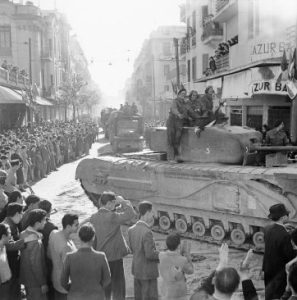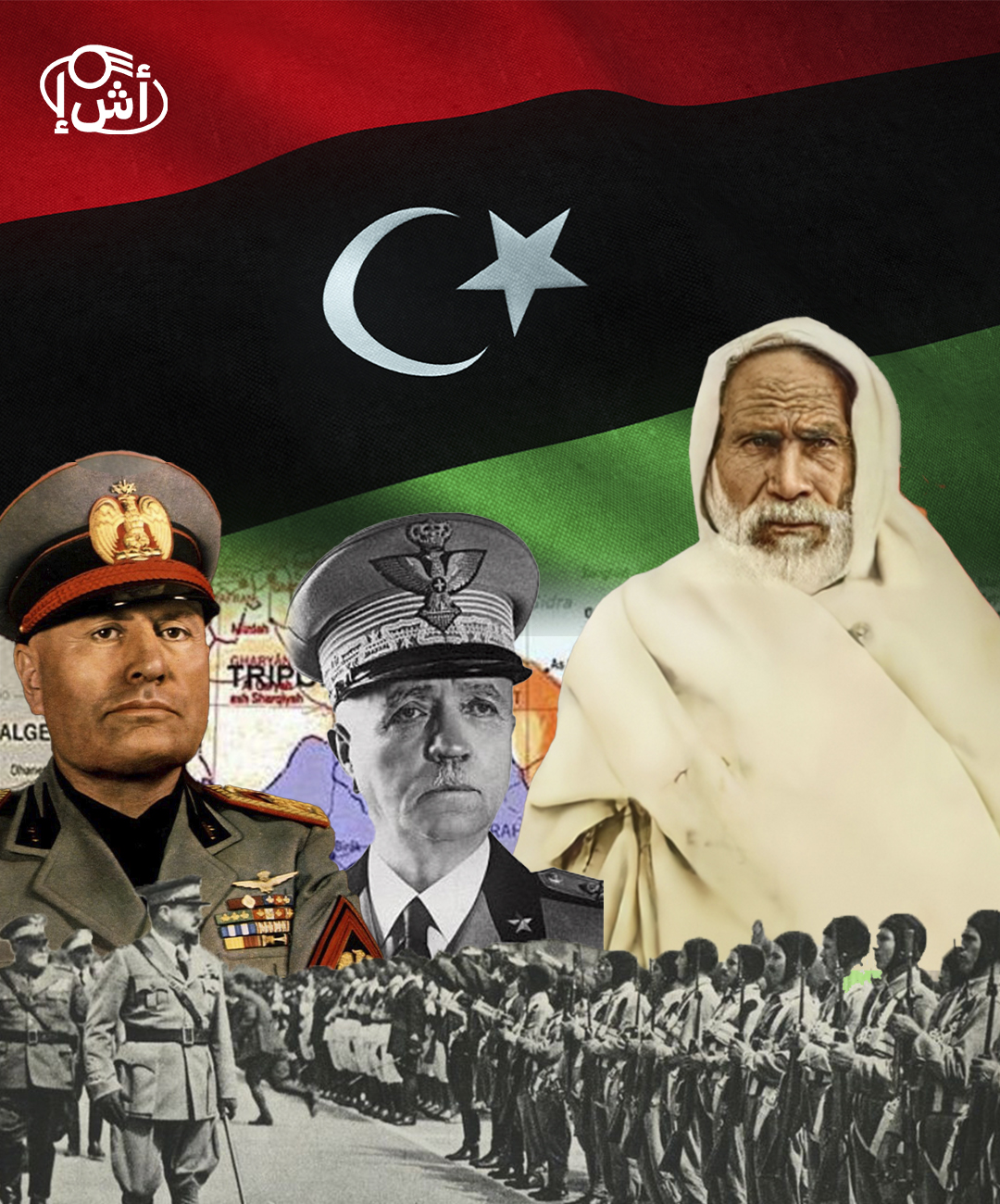Africa has always been coveted by European colonialism, both because of its geographical location and because of its natural resources on which the colonizers relied to build modern Europe.
The situation was not much different in the 21st century, as Europeans still continue to exploit the continent’s natural resources, this time using “democratic discourse” as a new means to try to impose control over the former colonies.
In this article, we discuss the ways in which the colonizers tried to continue to control their colonies, after a historical account of the ways Italy followed, and the accompanying conditions it invested in plundering Libyan and African resources.
The beginning of colonialism
Italy began expanding into Africa and building colonies since 1882. In 1911, in parallel with the weakness and disintegration of the structure of the Ottoman Empire, Italy took advantage of an agreement it signed with Russia regarding the Straits, and obtained support from Britain and France, its partners in sharing the “African booty”, to send its troops and begin the occupation of Libya.
After heavy bombardment of Tripolitania and a series of attacks and military operations, the Ottoman Sultan issued a decree on October 15, 1912, granting full autonomy to both Tripolitania and Cyrenaica, and the forces of the Ottoman Sultanate withdrew, leaving the country to face the Italian invasion on their own.

Italy considered the Ottoman withdrawal a victory and managed to occupy Tripoli one year later.

Italy annexed Tripolitania and Cyrenaica together in its colonial project
War crimes. And a small dictator
Between 1915 and 1918, Italian control in Libya was limited to ports in Tripoli, Derna, and Benghazi. This was insulting to Italy’s colonial ambitions.
Moreover, Italy was forced to make concessions to the Arab and Amazigh tribes that resisted. The resistance of the population was so strong that Italy concluded a peace treaty granting Tripoli the right to hold parliamentary elections, freedom of the press, and the granting of Italian citizenship to the Libyan Muslim population.

Italian colonial forces in Libya
In 1920, the Italian authorities recognized Muhammad Idris al-Senussi, the leader of the Senussi Sufi order, and concluded with him the first autonomy treaty in Cyrenaica.
In 1923, Benito Mussolini began looking for “full control of the colonies”, he wanted all the natural resources to be harnessed to serve Italy.
In North Africa, the fascists managed to capture the Gulf of Sidra, similar to the Roman Empire.
The Italian dictator wanted to begin expansion and conquest across the Sahara, Cameroon, the Atlantic coast, and the Horn of Africa.
At the same time, the popular resistance movement was growing, and the southern Fezzan region became a refuge for most of the tribes who fought the Italian invaders in small groups.
The First Basis of Colonialism: Capture of Resources
The fascists began a new phase of colonial warfare, targeting not only local resistance, but against the entire population. Under the slogan “Restoring Fascist Libya”, Italy began occupying the entire country, Tripolitania, Fezzan, and Cyrenaica.
Initially, they only “pacified” Tripoli, where four-fifths of Libya’s fertile territory is located, in 1923.
The entire policy of conquest was aimed at seizing arable land and destroying the traditional Islamic tribal structure of Libyan society. The local population was driven out of fertile coastal areas to arid regions, bringing in Sicilian farmers.
In 1923, Italian Governor Giuseppe Volpi issued a decree confiscating all land belonging to Libyan “rebels” or people supporting the resistance. Governor Volpe acquired for himself two million hectares of land to become the largest landowner in North Africa.

Sicilian peasants arrive in Tripoli in 1929
Colonization tactics
Italian colonialism carried out numerous ethnic cleansing, disarmament, arrests, and executions against Libyan resistance, using Eritrean soldiers, who were known for their cruelty and sadism at the time.


The Royal Italian forces bombed everyone who tried to withdraw and take refuge in Egypt or Algeria
The second basis of colonialism: intimidation and intimidation
Mussolini used poison gas in Libya, and its ruler, Emilio de Bono, liked to closely monitor the deadly consequences of poison gases. The tragedies of January 6, 1928, in a well-known carrion oasis: the destruction of a rebellious Moroccan tribe with mustard gas.

The Italians ran their colony in Libya with unprecedented cruelty and sadism
Italy committed crimes and atrocities, and Mussolini used poison gas, despite signing in 1925 the Protocol to the Geneva Convention prohibiting the use of asphyxiating, poisonous or similar gases in military operations.
Resistance to colonialism
The Senussi order maintained its presence and occupied a great place in the society of Cyrenaica, as well as providing shelters and places for meetings, religious rites and the management of resistance operations. Omar al-Mukhtar commanded between 2,000 and 3,000 desert fighters.
To crush the resistance whose star was shining, Italian Lieutenant Governor Graziani ordered the installation of a barbed-wire fence 270 to 300 kilometers long and 4 meters wide with fortified checkpoints along the border with Egypt. The rebel fortifications cut off the supply of weapons and the resistance suffered a blow from which it could not recover.
The decisive defeat of the resistance was inflicted on September 1931. During the battle, Omar al-Mukhtar’s horse stumbled and threw the more than seventy-year-old Libyan leader. The Italian court sentenced him to death by hanging in public.

Concentration camps
In April 1926, Mussolini visited Tripoli and announced the beginning of a new fascist policy in the Eastern Mediterranean and Africa. Italian military actions in Libya escalated to the point of genocide.
General Graziani intensified repression, closed the border with Egypt, increased the frequency of bombardment with poison gas bombs, and established concentration camps.

Rodolfo Graziani, war criminal
Italian forces expelled the population to deny the uprising any support, seizing territory and placing it under their authority.
About half of Cyrenaica’s population was displaced at the time, and the forced deportation, which took place with incredibly cruelty from July to December 1930, affected 100,000 Libyans.
In 15 concentration camps in southern Benghazi and Sirte, prisoners died of typhoid, dysentery, starvation, torture, and rape. 40,000 Libyans will never return home. The concentration camps were not terminated until October 1933.

Italian concentration camp in Egaila
In 1939, Rome declared Libya an integral part of the territory of Italy and the Italian nation.

In 1930, the Italians took 100,000 men, women, and children from Cyrenaica to concentration camps, and over the next three years, between 60,000 and 70,000 prisoners died [GALLO/GETTY]
In the footsteps of the Nazis. A generation of Mussolini Arabs
After 1932, Libyans gained more rights, primary education emerged, and concentration camps were closed. Benito Mussolini began to call Libyan Arabs “Italian Muslims” and call himself their defender.
Badoglio opened a branch of the National Fascist Party of Libyans (Islamic League of Ectors). Through this association, the local population was able to obtain Italian citizenship selectively.
The third basis of colonialism. Destruction of national and cultural heritage

Pietro Badoglio, the first Italian governor-general of Tripolitania and Cyrenaica
Spy cells formed in neighboring Egypt. Egypt’s future presidents, Anwar Sadat, and Gamal Nasser were in contact through intermediaries with the League when, with the help of German intelligence, they sought to organize an uprising in the country.
The fourth basis of colonialism. Building a new generation that owes loyalty
A corresponding formation was created for the Nazi “Hitler Youth” organization in Libya, controlled by fascist Italy, called the Arab Lector Youth.
Through this organization, it provided many services such as education, sports, and military training, in a way that provided Libyan youth with a suitable career path to serve Italian colonialism, whether in stealing the country’s wealth or in the army.

A fascist generation of Libyan children
Stain
Ten years were not in vain. Libyans, according to Mussolini, have become obedient followers. After the outbreak of World War II, they became loyal implementers of the will of the colonizers.

The beginning of the war in North Africa
The shameful loss of the war to Italy and Germany, and the Allied expulsion of the Italians from Libya and Tunisia, marked the beginning of the end of the colonial marathon in Libya.

Mocking end
With the end of the fascist regime, the Italian settler-colonial project in Libya also ended. After the war, Libya became an independent kingdom led by Muhammad Idris I, the exiled leader of the Senussi.
The king will be overthrown by Gaddafi, who will finally cleanse Libyan territory of Italian influence, but lose to the new colonizers. On 30 August 2008, Italy will sign a treaty recognizing its crimes and apologizing for the damage done to the Libyan people during the Italian colonial period. It would be the first time in history that a country would apologize and provide reparations to those who suffered from colonialism.
These apologies will not stop Libya’s colonization policy, a new kind of colonialism will emerge for resource-rich Africa, and a densely populated Europe, equipped with an arsenal of modern weapons, concerned about its lack of resources, continues to divide the continent.
To be continued…
Libya… The Supreme Council of State prefers Morocco to host the new talks
